Past and Future of Nippon Subculture Jomon special ~JOMON・Art・Subculture~
さて、長かったモノノケの話が終わり(前回)、次は怪獣の話でも書くかなー、と考えていたのですが、今回は北海道・北東北の縄文遺跡群が世界遺産に登録された記念の『縄文特集』ということで、JOMONについての話を書きたいと思います。ということで“縄文・アート・サブカルチャ”というサブタイトルにしてみましたが、これでもまだ切り口の幅が広すぎます… そこで思いついたのが僕が代表を務めさせてもらっている(のはずだよね?)NPO法人JOMONISMが開催してきたアート展、『ARTs of JOMON』(以下:AOJ)に出展してもらったアート作品を紹介することによって、モザイク的に僕の考える“縄文・アート・サブカルチャ”とはなんなのか?ということを伝えるという試みです!会場に来ていただいたお客様には、”何故この作品を選んだか”、“この作品がどう縄文”なのか等を説明させて頂きましたが、文字として書くのもアーカイブ的に良いかと思っています。
Now that the long Mononoke story is over(previous article), I thought I’d write about kaiju next, but this time I will write about JOMON, as this is a “Jomon Special” to celebrate the Jomon Prehistoric Sites in Northern Japan being registered as a World Heritage Site. I named the subtitle “Jomon, Art, and Subculture,” but it’s still too broad… That’s when I came up with the idea of introducing the artworks that have been exhibited at “ARTs of JOMON” (AOJ), an art exhibition held by the NPO JOMONISM, of which I am the representative ( supposed I still am, right?).By introducing them, I’m trying to convey what I consider to be “Jomon, art, and subculture” like a mosaic of ideas .I explained to the audience who had came to past AOJ ” why I chose this work” and “how this work is Jomon”, but I thought it would be good to write it down as an archive.
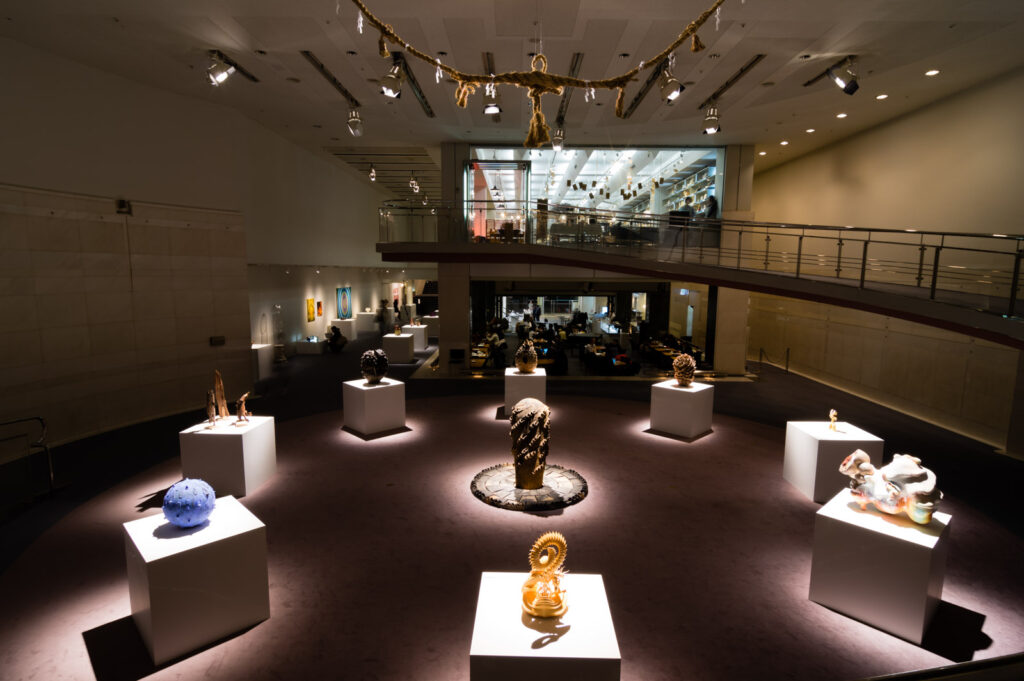
まずはざっくりAOJの概要から。現代のアーティストで縄文から影響をうけているアーティストは沢山います。岡本太郎氏が、いわゆる縄文を“再発見”し、”縄文が日本最古のアートフォーム”として認識されるようになったことは有名ですが、他にも多くの素晴らしいアーティストが縄文から受けた影響をそれぞれの中で解釈し、多様な作品を創りだしています。AOJは現代縄文作品を日本や世界各地で展示することにより、太古と現代をアートの力を持って繋げ、巨大な文化の円環を創りだすという試みです。モダン的価値観、社会、経済が音をたてて崩壊している今、モダンに変わる価値観が早急に必要とされています。僕はそこにハマるものが、テクノロジによってアップデートされた、縄文的、アニミズム的な価値観、日本的なアルカイック・リバイバルだと信じています。より平和で、寛容で、アートな社会が実現するように、毎回会場のレイアウトを構成する時もアートの力を触媒とした呪術の符を打つ気持ちで創っていました。
Let’s start with a brief overview of AOJ. There are many contemporary artists who have been influenced by the Jomon. Taro Okamoto‘s “rediscovery” of the Jomon and its recognition as ” Japan’s oldest art form” is well known. But there are many other great artists who have interpreted the influence of the Jomon in their own ways and have been creating diverse artworks. AOJ is an attempt to create a gigantic circle of culture by connecting past and modern times with the power of art, and exhibit those contemporary Jomon artworks in Japan and around the world. Modern values, society, and the economy are crumbling with a thud, and we urgently need a new set of values to replace the modern ones. I believe that what fits into this is the Japanese archaic revival of Jomon and animistic values, updated by technology. Each time I created the layout of the venue, I did so with a sense of casting a spell, using the power of art as a catalyst, so that a more peaceful, tolerant, and artistic society could be manifested.
2013年、ニューヨークのhp Galleryでの初展示を皮切りに(この時のキュレーションは後で紹介する金氏)、パリでのジャパンエキスポ(2013)、青森県立美術館(2014)、スパイラルガーデン(東京、2015)、デンバー国際空港(コロラド州、米国、2015)、ISETAN The Japan Store(クアラルンプール、マレーシア、2017)、紀尾井町ガーデンテラス(東京、2017)と色々な場所で展示をさせて頂きました。2020年にはストーンヘンジでの展示を予定していたのですが、他のアートイベント同様コロナの影響で中止になってしまいました。
In 2013, we had our first exhibition at hp Gallery in New York (curated by Riyo Kim, who will be introduced later), and then we had exhibitions at Japan Expo in Paris (2013), Aomori Museum of Art (2014), Spiral Garden (Tokyo, 2015), Denver International Airport (Colorado, USA, 2015), ISETAN The Japan Store (Kuala Lumpur, Malaysia, 2017), and Kioicho Garden Terrace (Tokyo, 2017), and we exhibited at various places.In 2020, the exhibition was scheduled to be held at Stonehenge, but like other art events, it was cancelled due to the COVID-19.
それではAOJに出展してくださったアーティスト/作品を紹介していきたいと思います。僕がアーティストに出展をお願いする基準は“縄文的であること”と”エッジが立っている”ということです。縄文“的”というところがポイントで、現代の縄文アートは必ずしも土器でなくても、縄文文様を使用していなくても良く、その作品を創った精神性であったり、アーティスト自身が縄文的であれば良いと考えています。
I would now like to introduce the artists and works that have been exhibited at AOJ. My standards for asking artists to exhibit their work are that it must be “Jomon-like” and “edgy”. The Jomon “-like” part is the key. Contemporary Jomon art doesn’t necessarily have to look like doki (earthenware) or use distinctive Jomon patterns, as long as the artist or the spirit that created the work is Jomon.
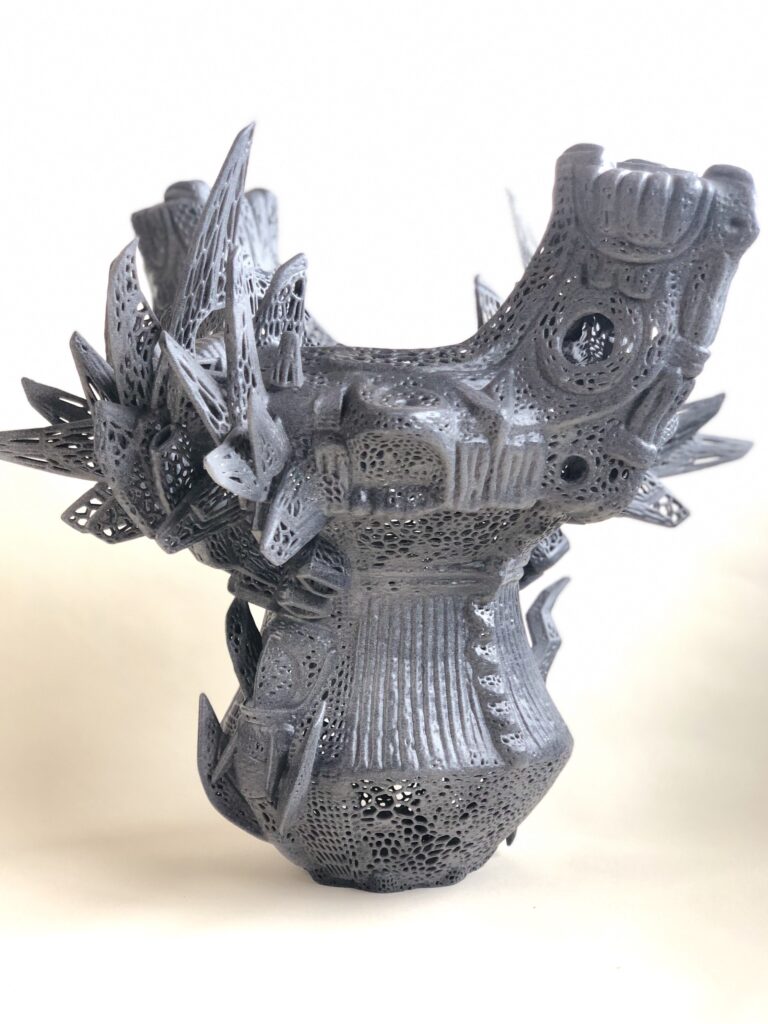
まずはいきなり手前味噌ですが、”XSENSE”の作品から。XSENSEは僕と、アーティスト坂巻善徳 a.k.a. sense(IG:@sense_art_jp)氏(以下:センス)のコラボレーションプロジェクトです。テクノロジとアートを融合し、平和な社会や世界を実現することを目的としています。3Dプリンタ、CNC、カーボン成形など様々なデジタルテクノロジを駆使して、センスの描くカタチを多様なアート作品として展開しています。(artstation) AOJには初回から出展していますが、その中から何点か作品を紹介します。『Spectrum of Consciousness』は山梨県韮崎市、石之坪遺跡から出土した縄文時代の土器、その土器を3Dスキャンしたデータをお借りし、コンピューターグラフィックソフトの中でセンスが描いたカタチを3D化したものと融合、3Dプリントで出力し作品としています。本来であれば改変/改造できない縄文遺物をデジタル化することにより、より自由にアート作品として活用できるということ、太古と現在を繋ぐということをヴィジュアルとして表現する、というのがコンセプトです。
First of all, I don’t mean to brag, but let’s start with the work of “XSENSE”. XSENSE is a collaborative project between me and the artist Yoshinori Sakamaki a.k.a. Sense.(IG:@sense_art_jp) Our goal is to realize a peaceful society and world by integrating technology and art. (artstation) XSENSE have been exhibiting at AOJ since its first show, and I would like to introduce some of my works from there. “Spectrum of Consciousness,” is made by borrowing 3D scanned data of Jomon doki excavated from the Ishinotsubo site in Nirasaki City, Yamanashi Prefecture, and fused it with shapes drawn by Sense and made into 3D by me in computer graphics software, and output them as 3D printed artworks. The concept is that by digitizing Jomon relics, which normally cannot be altered or modified, they can be utilizable more freely as artworks, and that the connection between the ancient and the present can be expressed visually.
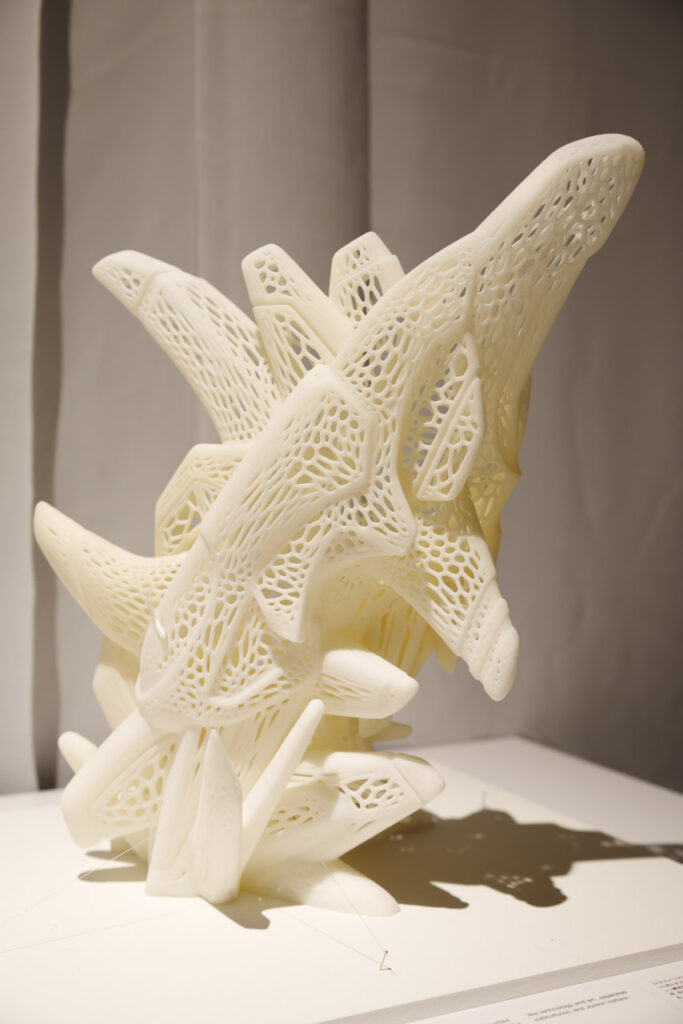
XSENSEのカタチ、キャラクター(というかオブジェクト)にはどんな意味があるのか?ということを良く聞かれます。これは僕個人の意見なのですが、センスの描くカタチは日本のサブカルチャ、特にロボットのデザインなどのもつ“カッコイイ”を一度解体し、アブストラクトに再構成したものだと思っています。そして“カッコイイ”という想いはアニミスティックな“畏怖の念”に繋がっているというのが僕の考えなのですが、それについては回を改めて書きます。
縄文土器とXSENSEどちらにも共通するのは“増殖型”のアートであるということです。粘土を積み上げることによって、文様を刻み続けることによって、またポリゴンのパーツを組み上げていくことにより、一つ一つは単純なカタチが重層的な情報の集積となります。
We have been often asked what the shape and character (or rather, the object) of XSENSE means. This is my own personal opinion, but I think that the forms that Sense draws are the result of deconstructing the “kakkoii”(coolness) of Japanese subculture, especially robot design, and reconstructing it abstractly. And I think the subcultural sense of kakkoii originated in an ancient animistic feeling of “awe”, but I will write about it in more detail in coming articles. What both Jomon doki and XSENSE have in common is that they are “proliferative” art. By piling up clay, engraving patterns, and assembling polygonal parts, each simple structure becomes a multilayered accumulation of information.
前述したとおり、現代の縄文アートは土器のカタチをしていなければならないわけではない、と僕は考えています。XSENSEは太古からの精神や形状を受け継ぎながらも、それを現代的なカタチで構成しなおした、未来へと向けた縄文です。そして、XSENSEで大事な部分はぼくとセンスが縄文的な平和な未来を創るというヴィジョンを共有していることだと思っています。
As I mentioned above, I consider that contemporary Jomon art does not necessarily have to be in the shape of Jomon doki. XSENSE is a Jomon for the future, inheriting the spirit and shape from ancient times, but reconfiguring it in a modern form. And I think the most important part of XSENSE is that me and Sense share the vision of creating a peaceful Jomon style future.

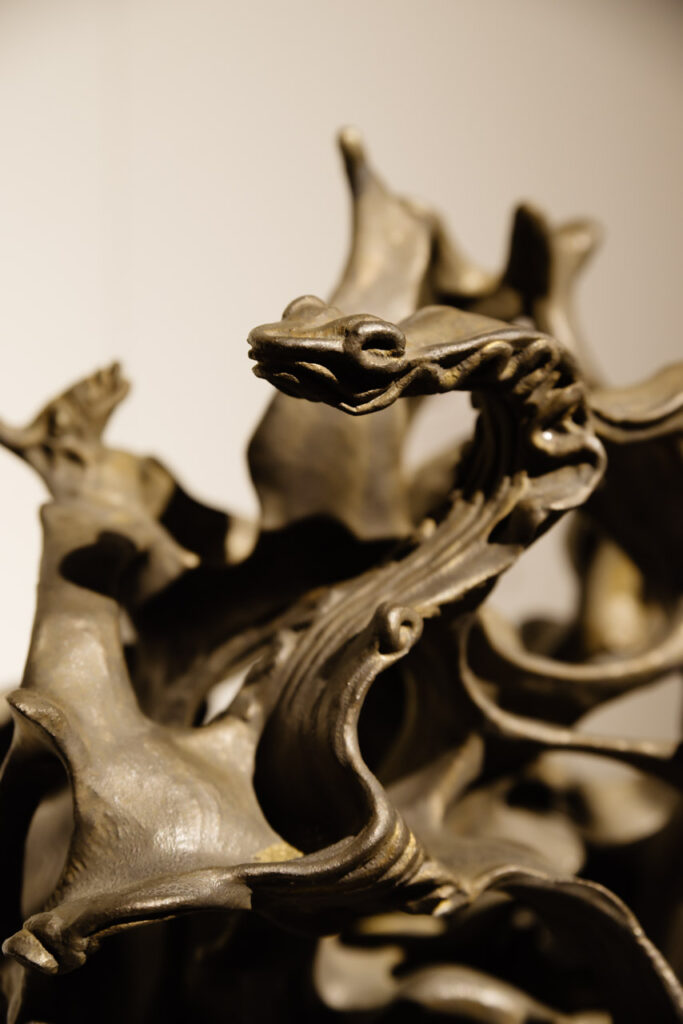
次に紹介するのはJOMONISMのメンバーでもある大藪龍二郎氏。(IG:@yaburyu)子供の頃には近所の崖で、よく化石掘りをしていたそうで、縄文土器を掘り当てたこともあるそうです。大藪氏の作品はどれも素晴らしいですが、その中でも『The Resonator』が大藪氏の代表作のひとつだと僕は考えます。確かな技術に裏付けされた造形、踊り立つ炎のような躍動感。文様やマチエール(注①)、全体から感じる雰囲気は確かに縄文なのですが、よく視るとこのような形式の縄文土器はみたことがないことに気が付きます。
Next up is Ryujiro Oyabu, who is also a member of JOMONISM.(IG:@yaburyu)When he was a child, he used to dig for fossils in the nearby cliffs, and sometimes dug up Jomon doki also. All of his works are excellent, but I consider “The Resonator” to be one of his masterpieces. Modeling backed by authentic skills, a sense of dynamism like a dancing flame. The patterns, matière (*1), and overall atmosphere are definitely Jomon, but if you look closely, you will notice that you have never seen this type of Jomon pottery before.
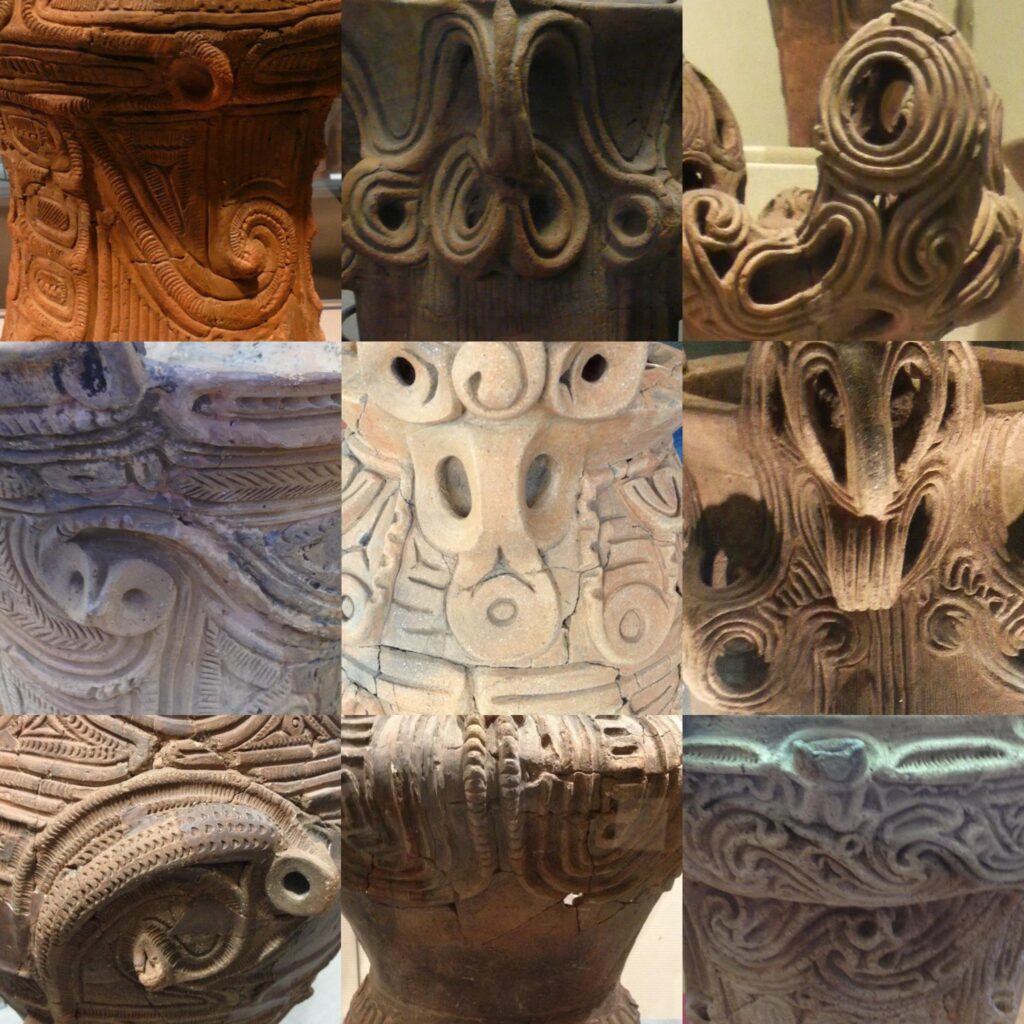
縄文土器は自由に創られていたように見えますが、各地域々々、村々によって記号(コード)が決まっています。それが村に伝わるストーリーを表現するために文様として彫りこまれたものなのか?はたまたカレンダーなのか?精霊の姿を表しているのか?今となってはその意味合いは推測することしかできませんが、土器をみていると確かにそこにキマリゴトがあることに気が付きます。
Jomon pottery seems to have been created freely, but each region, village has its own symbolic context (codes). Was it carved as a pattern to express a story passed down in the village? Or is it a calendar? Is it a representation of a spirit? Nowadays, we can only guess at the meaning, but when we look at the earthenware, we notice that there are indeed rules and regulations.
話は少し逸れますが、考古博物館等で縄文土器を視ていると、同じ遺跡から出土した土器、同じコードを持つ土器の中にも、マスターピースと呼べる作品が一つ二つとあって、それを模倣して作られたと見て取れる土器があったりします。しかしコードを模倣している方の土器は出来がイマイチだったりして、視ていて微笑ましいです。さらに、同じコードを共有する地域の土器の中にたまに怪異な姿をした、コードを自分流にアレンジしすぎた土器があります。
きっと、アーティスト肌の作り手が、同じ文様を作り続けることにキレて、自分オリジナル土器を制作。そのことにより師匠から破門をくらい、他の地域の土器職人と腕比べをするための旅にでる…というようなストーリーを妄想しています(笑)。
This is a little off topic, but when you look at Jomon pottery at an archeological museum or other such places, you will find that among the pottery that has been excavated from the same site or has the same code, there are one or two pieces that can be called masterpieces, and there is pottery that can be seen as having been made by imitating them. However, the pottery that mimics the code is not very good, which makes me smile seeing the effort of ancient artists. In addition, there are occasionally monstrous-looking pottery from regions that share the same code and have arranged the code too much in their own artistic way.
I’m imagining a story that the creator, who has an artist’s temperament, is furious about having to keep making the same patterns, and creates his own original earthenware. For this reason, he is excommunicated by his master, and sets out on a journey to compare his skills with pottery makers in other regions… lol
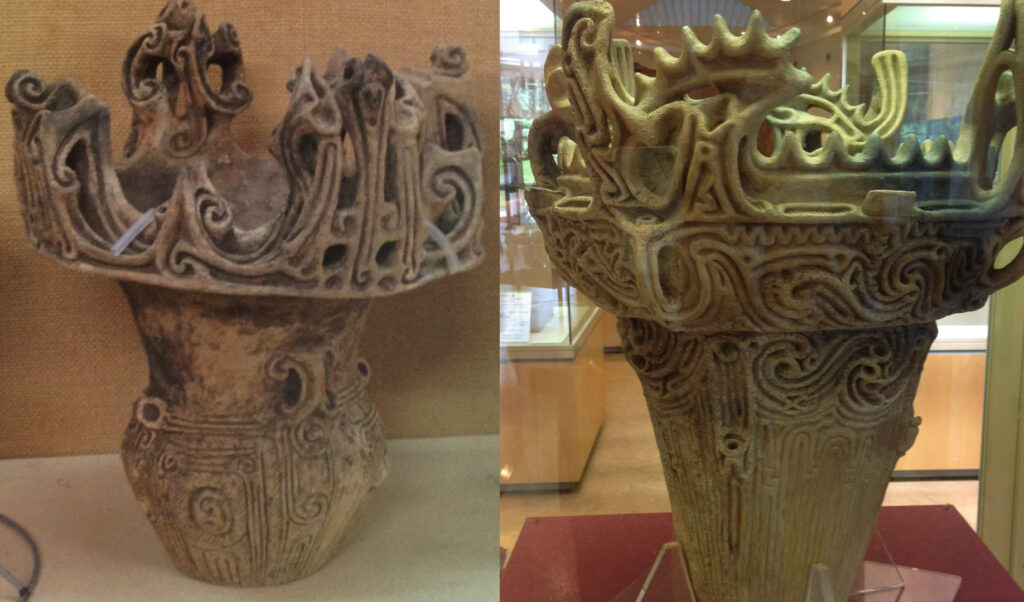
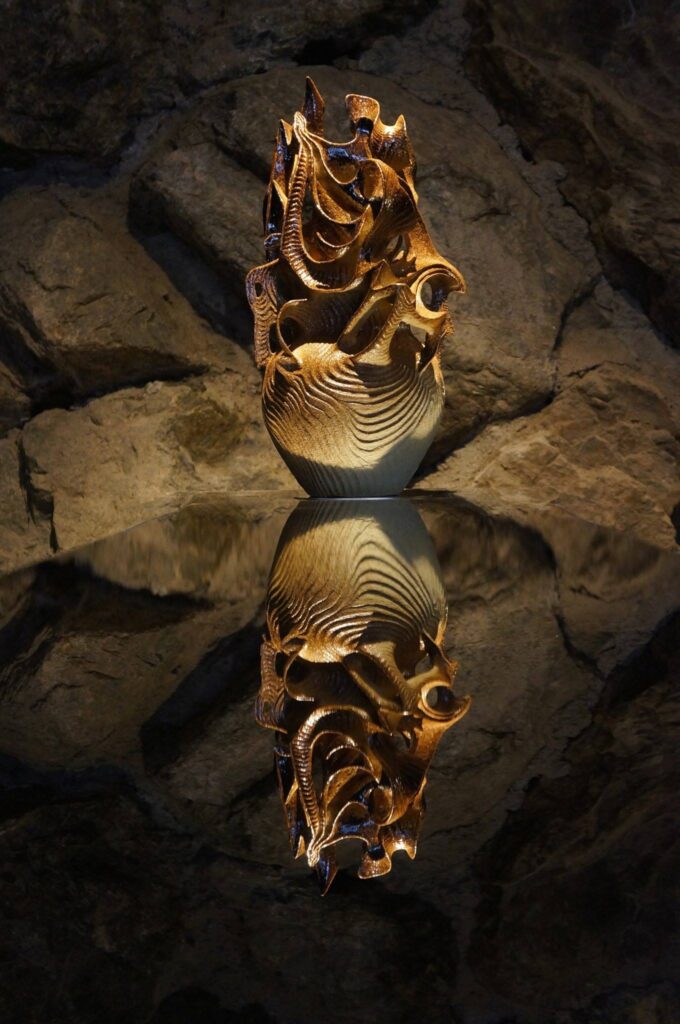
話を戻すと、大藪氏は土器を作っているけれどそこにあるコード自体が非常に新しいものになっていて、コードがもっとフリースタイルで現代的です。現代に生きるアーティストがつくっているものなので、文様/形状のコンテキストが現代的になるのは当然のこととはいえ、それが土=粘土というプライマルな素材と融合して大藪作品の感覚、洗練と荒々しさを兼ね備えたバランスを生み出しています。
Back to the topic at hand, Oyabu is making doki, but the “code” itself is very new, and the code is more freestyle and modern. Since they are made by artists living in the modern age, it is only natural that the context of the patterns/shapes would be modern, but this is fused with the primal material of soil = clay to create a excellent balance that combines the sense of Oyabu’s works, sophistication and roughness.
技術的にも縄文土器は野焼き(注②)、現代の陶芸は窯を用いて作品を焼成しますが、これによっても作ることができる形状、仕上がった時の材質に違いがでてきます。大藪作品は同じ粘土を使った焼き物というカテゴリーにありながらも、現代の感覚と技術を使った縄文土器、縄文文化の拡張であり、現代陶芸における縄文の追及なのです。
Technically, Jomon pottery is fired in noyaki, open-hearth firing(*2), while modern pottery is fired in a kiln. This also makes a difference in the shapes that can be made and the matière when it’s finished. Although Oyabu’s work is in the category of pottery made from the same clay, it is an expansion of Jomon pottery and Jomon culture using modern sensibilities and techniques, and a pursuit of the Jomon in contemporary pottery.
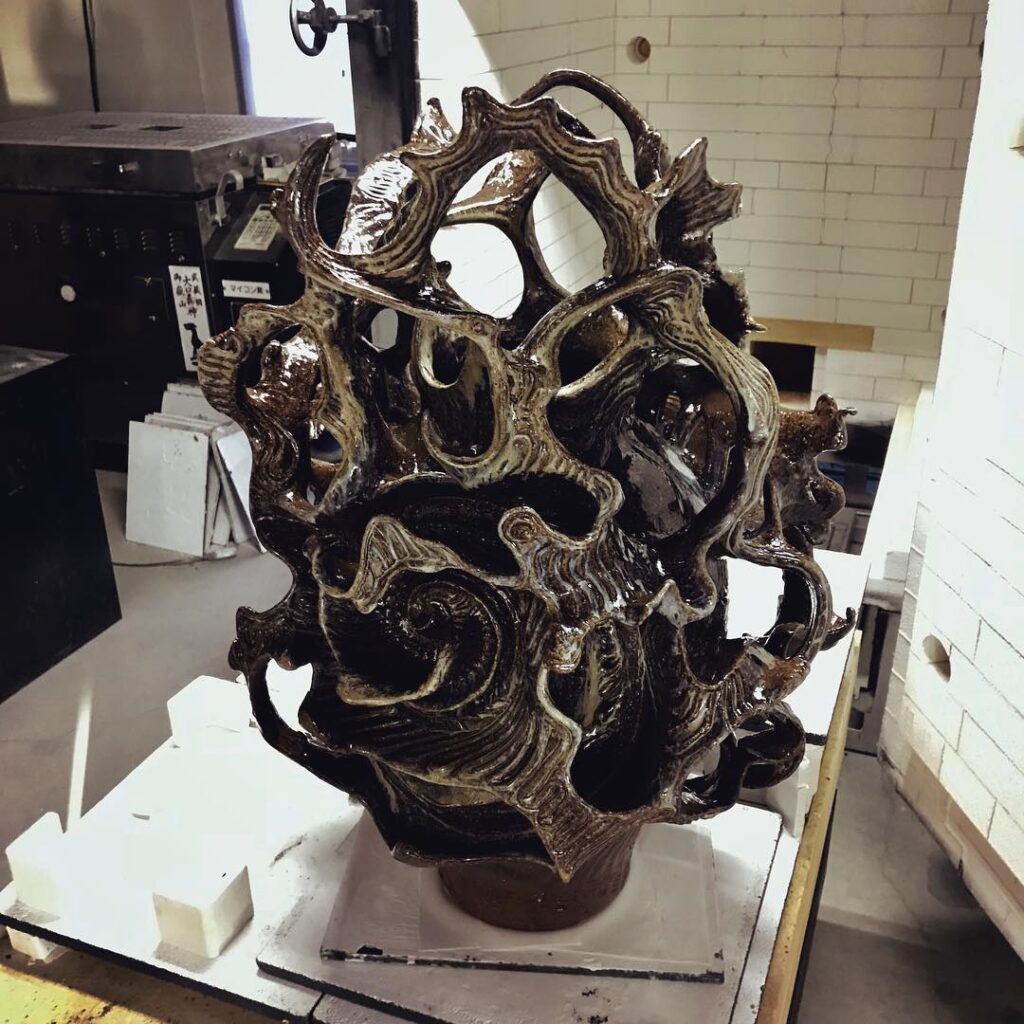
このペースで行くと全てアーティストを紹介するのは難しそうですね…。しかし次回もAOJに参加してくださったアーティスト/作品を紹介しながら、僕のJOMONコンセプトについて書いていきます。
At this pace, it’s going to be difficult to introduce all the artists…. But next time, I will continue to introduce the artists/works that participated in AOJ and write about my JOMON concept.
注① matière : 材料。材質。特に美術では、さまざまな素材や、その種々の使用法によって作り出された画面の肌および、その材質感、質感の与える心的印象。
matière:Material. A texture. In art in particular, the skin of a screen created by various materials and their various uses, and the mental impression given by the sense of material and texture.
注②「野焼き」というのは,地面の上,もしくは地面を浅く掘り下げた穴の中で火を焚き,そ の熱で焼き物を焼く方法のことを指す。より詳しくは
The term “Noyaki”(open-hearth firing) refers to a method of burning pottery by building a fire on the ground or in a shallow pit dug into the ground and using the heat from the fire. For more information
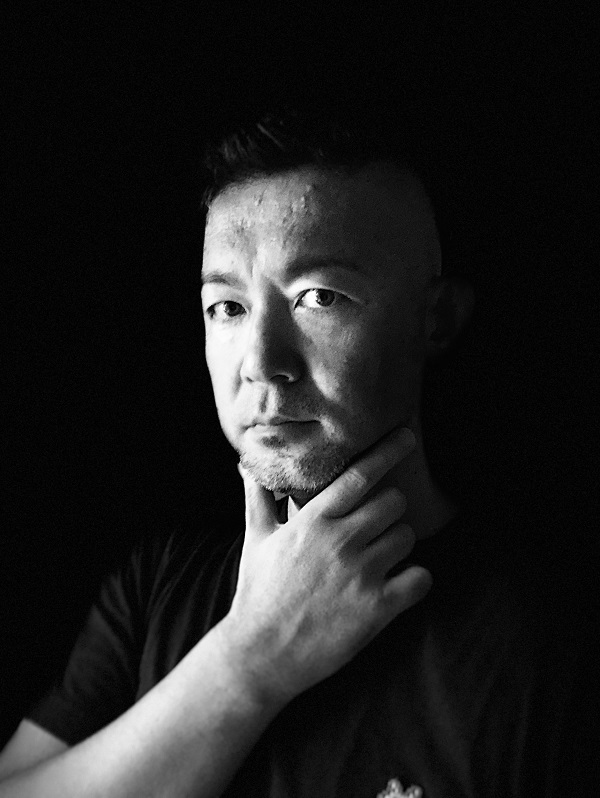
小林 武人 ポストデジタル・アーティスト
Taketo KOBAYASHI Post-digital artist
ARTSTATION
Taketo Kobayashi (artstation.com)
Instagram ID
@humanoise
NPO法人JOMONISM 代表
https://humanoise.artstation.com
慶應義塾大学 環境情報学部卒。東京工科大学クリエイティブ・ラボ、株式会社ゴンゾを経てフリーランスに。現在は“ポストデジタル・アーティスト”として、CGや3Dプリント等のデジタルツールを“筆”として使いこなし、立体作品から映像まで幅広く制作。海外でも積極的に活動しており、美術家 坂巻善徳 a.k.a. senseとのコラボレーションプロジェクト“XSENSE”では、デジタル作品をストリートアートに活かし、ミューラル(壁画)を制作(コロラド州、デンバー)。また、独自の世界観のアニメーションを舞台美術として使い、コンテンポラリー能劇団とコラボレーションで公演も行った(サンフランシスコ、デンバー)。
自身の作品制作の他に、NPO法人JOMONISMが行う”ARTs of JOMON”展のキュレーションも担当。縄文文化から影響を受けた現代美術作家を世界に紹介し続けている(青森県立美術館、スパイラルガーデン、デンバー国際空港、クアラ・ルンプール等)。
目に見えないモノ、感情、エネルギー、意識の次の次元…等をカタチにすることがミッション。
現在はシンガポール在住
After having experience of 3D graphics and animation at Tokyo Institute of Technology creative laboratory, and Gonzo Co., Ltd., Taketo started his own project as an artist. Using digital technology like CG, 3D printing as his “brush”, Taketo creates a wide variety of artworks from 3D printed sculpture to animation. In a collaboration project XSENSE, Taketo utilizes CGI in street art to create murals(Denver, CO, USA), also using his unique style animation for stage design and collaborated with contemporary Noh theatrical group. In addition to creating his own artworks, Taketo curates the group art show “ARTs of JOMON” hosted by Japanese non-profit JOMONISM, keep introducing contemporary artists/artworks influenced by ancient Japanese Jomon culture.(Aomori Museum of Art / Spiral Garden / Denver International Airport / Kuala Lumpur)
It is Taketo’s mission to make invisible things, emotions, energy, next dimensions of consciousness into “shapes”.
職歴・作品履歴(抜粋)
2004年
TVアニメーション「岩窟王」:背景デザイン、モデリング担当
2005年
スズキ「バーグマン」WEBプロモーション:バーグマン、モデリング担当
2007年
NHK アニ・クリ「火男(ヒョットコ)」:デザイン、モデリング担当
2012年
「MYSTICAL ABYSS」
アメリカ、サンフランシスコ、コンテポラリー能劇団Theatre of Yugenの公演、Mystical Abyss でオリジナルアニメーション制作、ライブプロジェクション担当
2013年-
アメリカ、デンバー、Art Across Cultures, Hope Onlineなどと共同で公演に参加。デンバーアート・ミュージアム等でアニメーションのプロジェクションを担当
2014年
2月 NPO法人JOMONISM企画「ARTs of JOMON展」@青森県立美術館、キュレーション担当
5月 シンガポール南洋工科大学3DPコンペティション参加。カンファレンス招待
11月 企業コラボーレションアート参加:オークリーストア原宿店にて作品展示
2015年
1月 NPO法人JOMONISM企画「ARTs of JOMON展」@スパイラルガーデン、キュレーション担当
2017年
“ARTs of JOMON -Hyper Subculture-” 展 キュレーション担当
伊勢丹 the ジャパンストア、クアラルンプール、マレーシア
2018年
”YouFab Exhibition – Imagination Manifests”@青年廣場 HongKong “More Than Human”プロジェクト、3Dプリント義足を展示
2019年
グループ展『童心』出展 銀座ホワイトストーン・ギャラリー
2020年
「Lights to the Night」アーティストに選出。シンガポール、アジア文明博物館にプロジェクション・マッピング
受賞歴等
オリジナルアニメーション『祭』(2010)
シーグラフ・アジア アニメーションシアター入選
YAOYOROZシリーズ『薬師如来』(2013)
3Dプリント用3DCG作品。日本図学会モデリングコンテスト、入賞
『SC1-EXP』(2014)
3Dプリント作品に映像をプロジェクション・マッピングしたインタラクティブ作品。
逗子国際プロジェクション・マッピング・フェスティバル、グランプリ
More Than Human『type-Unicorn』(2015)
3Dプリント義足。Ufab Global Creative award、ファイナリスト
“Eisen Herz”(2016)
構造計算を用いた3Dプリントミニ四駆カヴァー
Ufab Global Creative award、ファイナリスト
Project/Art history(excerpt)
PROJECTS Digital G-O-D, UltraSuperNew gallery, Singapore, Jan 2020
Haw Par Villa RE•MIX
Chinese Cultural Centre, Singapore , Jan 2020
”Light to Night Festival” Projection mapping at Asian Civilization Museum, Singapore , Jan 2020
A SIGN OF THE TIMES EXHIBITION, Singapore , Jan 2019
”ARTs of JOMON” exhibit @ISETAN KL, Malaysia , Aug 2017, curation&direction
“Colorado Crush”, a mural festival in Denver, CO. Sept 2016, created artwork
“DMS” Collaboration with Canon June 2015, created&exhibited 3D printed prosthetic leg
”Oakley Exhibition” Exhibited artworks at Oakley store Harajuku, Tokyo, Oct 2014
AWARDS “Eisen Herz” Ufab Global Creative award Finalist. 2016. 3D printed cover for “Tamiya mini 4WD” using generative design
“More Than Human type-Unicorn” a 3D printed prosthetic leg. Ufab Global Creative award Finalist. 2015
“SC1-EXP” Zushi International Projection Mapping Competition, Grand Prix. 2014
“Yakushi-Nyorai”(2013)
3DCG model for 3D printing. Winning work at Digital modeling competition held by Japan Society for Graphic Science
Original CG animation ‘Matsuri’(May 2010)
Design, modeling, production coordination. A CG animation based on Japanese ‘Jomon’ culture. Created for promotion of Aomori Prefecture. Accepted at Siggraph Asia 2010. (On VIMEO: https://vimeo.com/25144961)